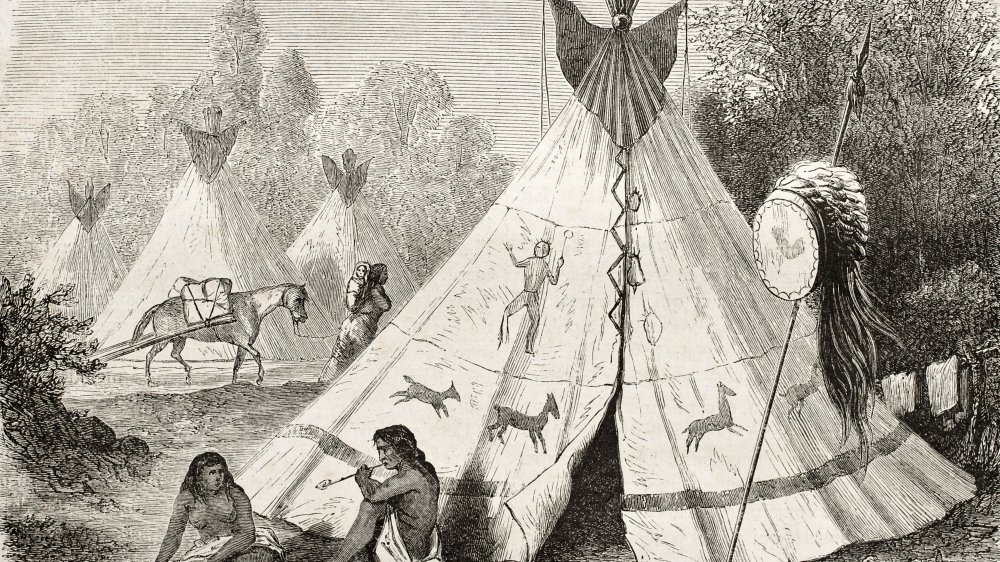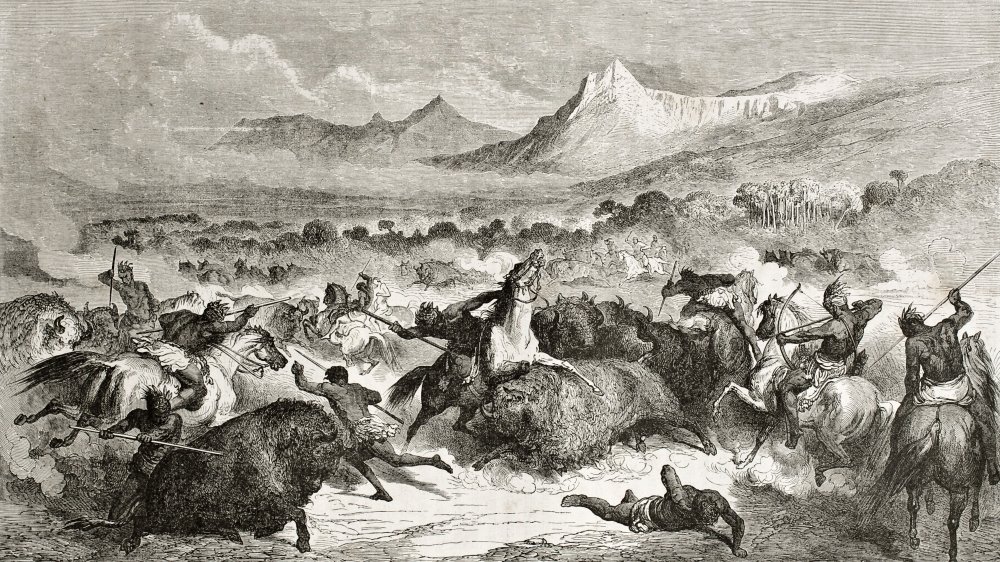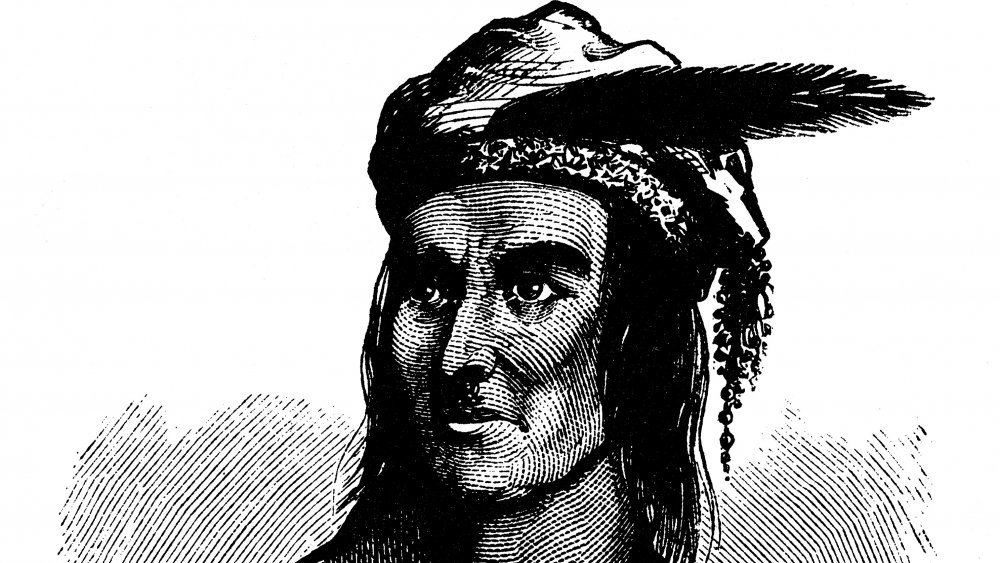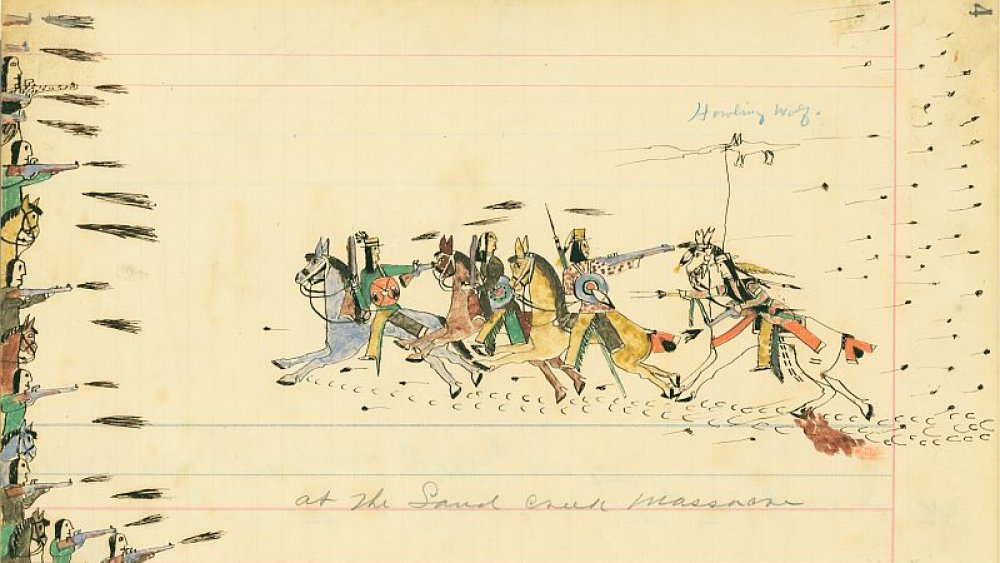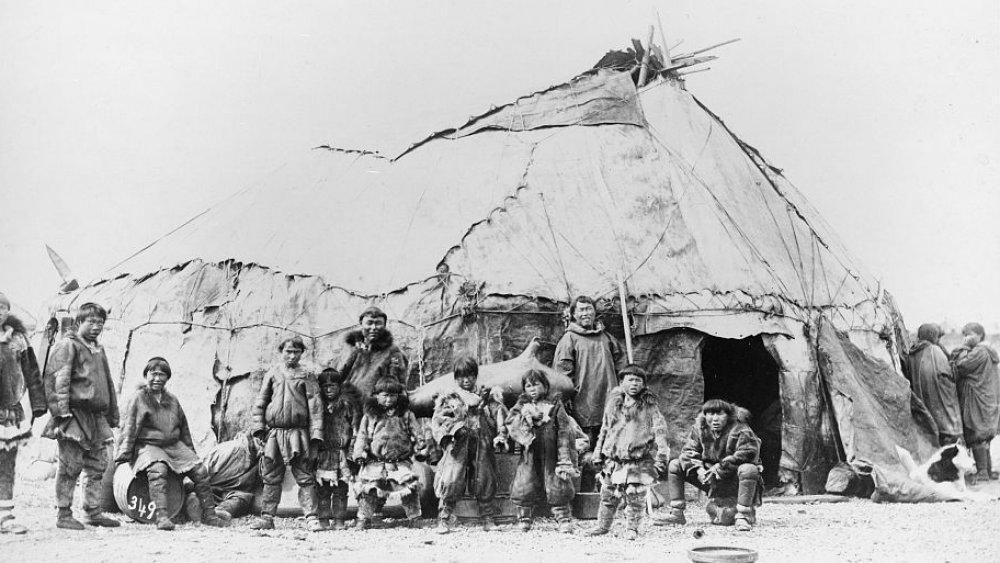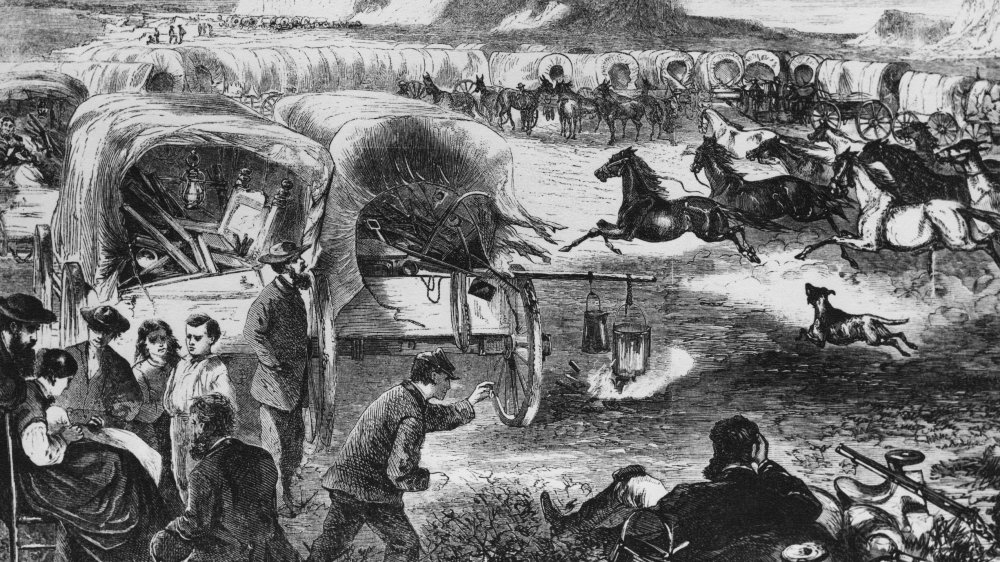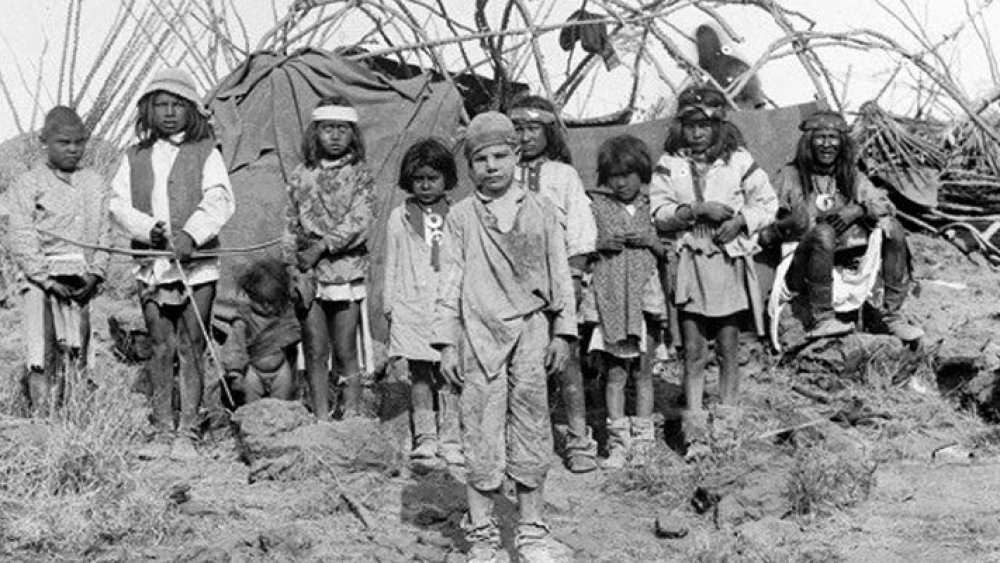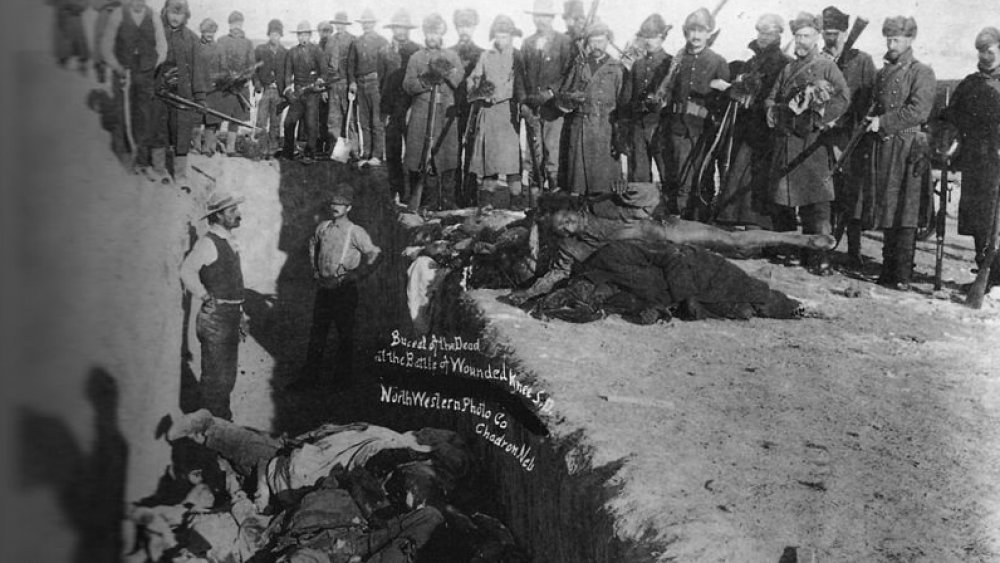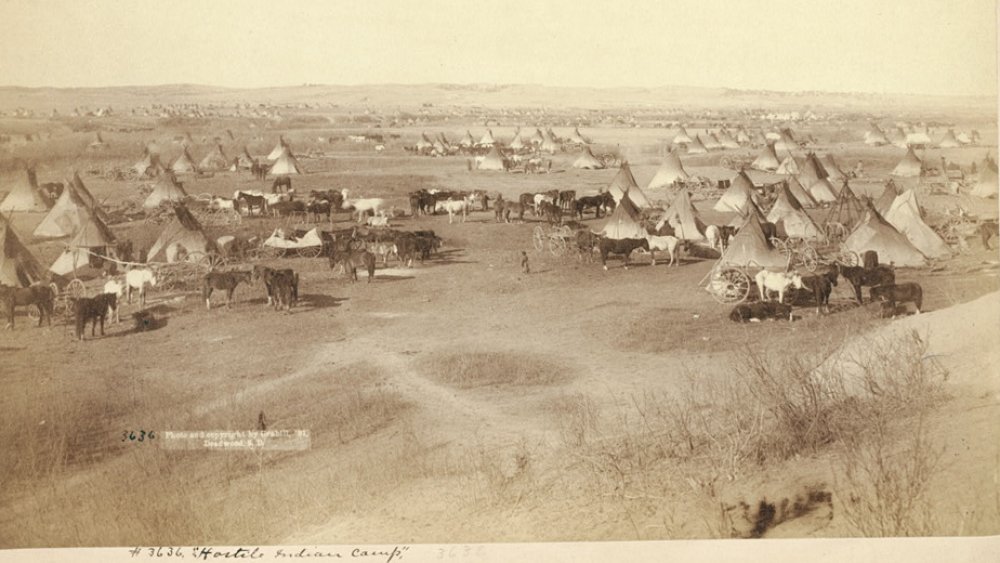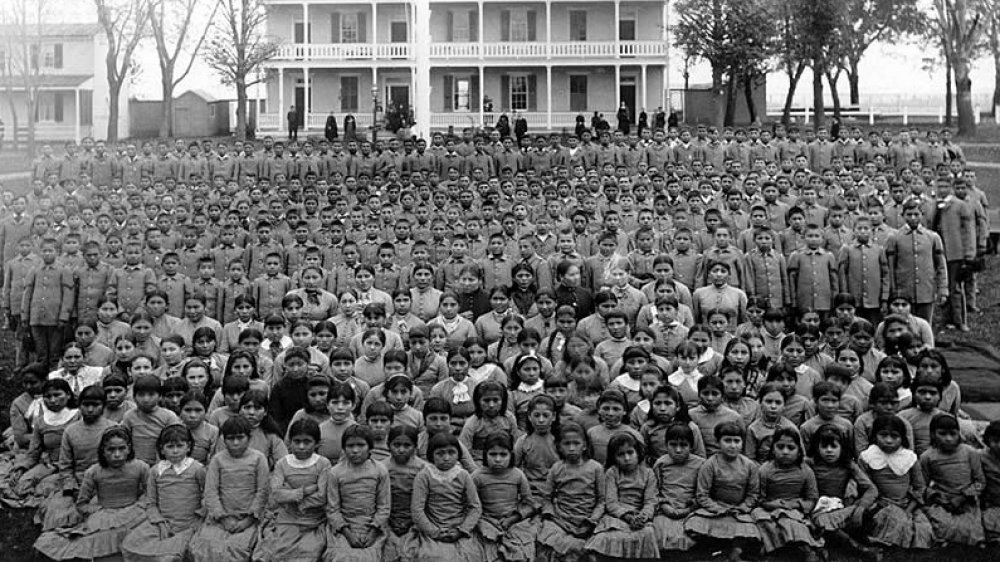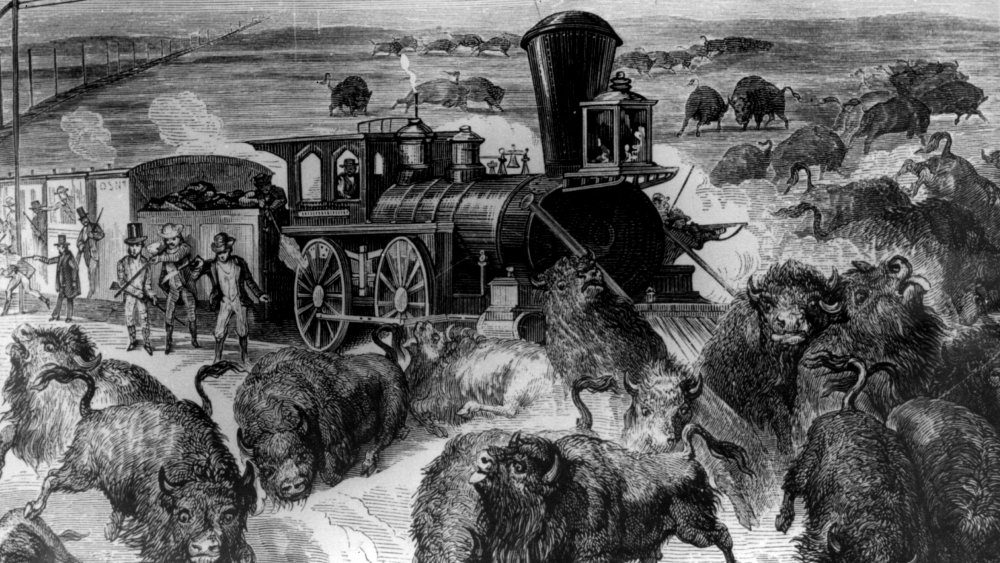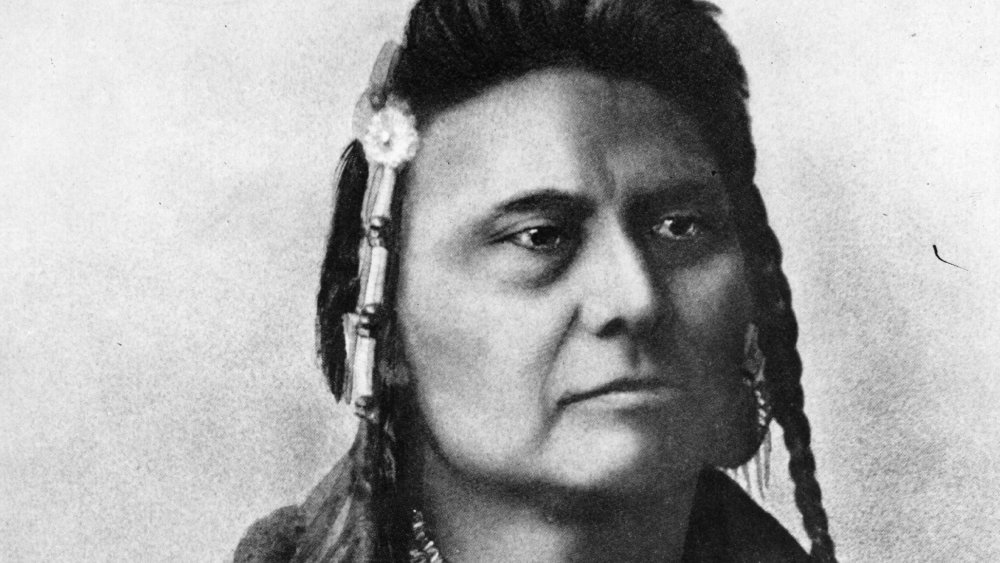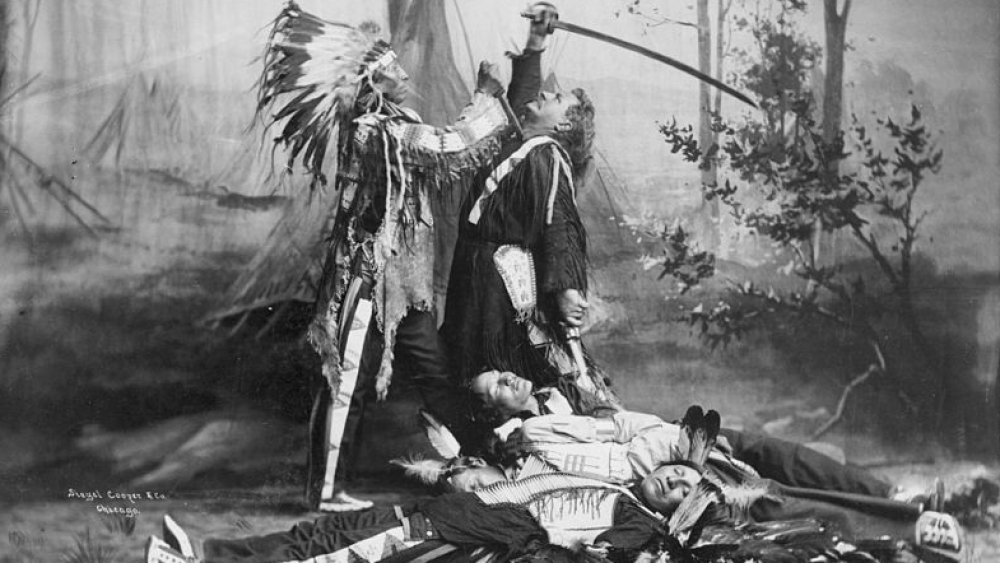What Life Was Like For Native Americans In The Wild West Era
One of the saddest — and most shameful — events in American history was the near-genocide of indigenous people across the nation. The Wild West era between 1865 and 1895 was particularly painful. White people coming west initially pictured the land as a wide open and virtually empty space for the taking. Instead, they found hundreds of thousands of Natives who had been living off the land for thousands of generations. Their way of life, so different from that of Americans, was considered unclean and unhealthy, even though most tribes were peaceful and friendly. Everything about them, from their languages to their way of dress and the way they lived, was different. To the pioneers, that was bad.
The trade agreements and treaties established between Natives and Anglos were initially agreeable, even as whites introduced such "dangerous" items as guns, alcohol, and disease. But when the Anglos decided they wanted the land which Natives had occupied for centuries, they figured the only way to get it was to take it by force and obliterate the very people who had initially welcomed colonists and pioneers to America. As more and more Anglos came west, they encountered, fought, killed, and pushed the Natives from their homelands to government-run reservations. American settlers not only failed to recognize the Natives' important survival skills but also their culture and spiritualism. Read on to see why, when, and how Anglos conquered the Natives of America.
A brief history of Natives in America
Per the BBC, the Natives of America were a nomadic bunch, made up of a number of different tribes. Each tribe was made up of smaller bands who moved around the plains and western mountains as many as six to eight times in a year. It was logical to hunt and gather in the higher country during summer and move to lower elevations during winter. Following the migrations of buffalo also was important, since the Natives depended on these animals for food, made tools from their bones, and used their hides for warmth. Their temporary camps were designed to be quickly and easily broken down for traveling. The people believed this was part of the grand design by their god and that they were destined to move as needed in order to survive.
Those tribes who did stay in place did so because they found an abundance of everything they needed and could plant seeds from the vegetables they ate. Wild berries, roots, and nuts were also beneficial. Farming, hunting, fishing, and trapping all provided excellent food sources. Especially along the Northwest Coast, Natives also benefited from additional food sources from the ocean. The tribes were able to build more permanent villages and even wood structures and had a highly evolved culture and social structure that included having more possessions as a means of higher status and vying for the attentions of the village leader.
Prelude to attempted genocide
Atrocities committed against Natives go back a long, long way. According to Legends of America, as early as 1775, missionaries in California sought to civilize Natives and destroy their way of life. Numerous battles between tribes would take place between 1776 and 1830 as children, women, and men were killed and their tribes retaliated by attacking Anglo settlements. Smallpox and measles, illnesses that were foreign to Natives, killed many of them. There were treaties, too, as the American government added an "Indian Commerce Clause" to the Constitution in 1789 to "regulate commerce" with certain tribes. By 1795, trade relations with French and Spanish traders began, but the American government just couldn't keep from outlawing the sale of liquor to Natives beginning in 1802.
The year 1804 marks the first time the government commanded Natives to move west of the Mississippi River. More treaties would come, and Shawnee leader Tecumseh (pictured) even established the ill-fated "Prophetstown" for Natives who wanted to stop Americans from infiltrating their land. All of these battles and efforts led to the Indian Removal Act of 1830, also known as the infamous Trail of Tears, wherein nearly 50,000 Natives were forcibly removed to Oklahoma. Finally, in 1862, the Dakota War was led by Sioux Natives who were sick of Anglos encroaching on their land. US troops eventually took 303 Sioux prisoners, of whom 38 men were hanged.
The Long Walk and the Sand Creek Massacre
Two significant attacks by Anglos against Natives occurred in 1864. One was "The Long Walk," which began in January. Over 8,500 Navajo were made to walk hundreds of miles from their lands in Arizona to the Bosque Redondo Reservation in New Mexico. Around 200 of them died from the elements or starvation along the way, and the reservation was "overcrowded and miserable." An 1868 treaty released the Navajo, who returned to Arizona but could only occupy a fraction of their land in Arizona and New Mexico in exchange for "basic services" from the government.
The other incident occurred on the banks of Sand Creek in November. As told by American Battlefield Trust, a band of Cheyenne and Arapaho, who had been promised protection from surrounding forts and were flying white flags, were attacked as they slept by Colonel John Chivington and 600 soldiers. Up to 163 natives were killed or wounded, mostly women and children. The dead were mutilated, and soldiers ransacked the camp. In the wake of the "battle," Chivington and his men went to Denver and were greeted by grateful citizens. Later, an investigation found that Chivington and his troops "fabricated a reason for the attack." They were never punished, and it is notable that Anglos now define their victories as battles, while Native victories were called massacres.
The Native way of life
Because they lived in the wilderness, Natives were highly in tune with nature. They knew to hunt, fish, and gather berries in summer and hunt while living on stored food in winter. They used the natural materials around them to build their shelters and used animal skins for clothing, bedding, and blankets. All tribes were hunters and gatherers. They believed that animals were a gift for their use as a way to sustain the tribe and respectfully prayed and thanked those they killed. Men primarily hunted, while women dressed and divided the kills for a number of uses — so both genders were integral to making their communities function.
Women weren't just keepers of the camp. Aside from cooking and looking after their families, they also fashioned tools and weapons, gathered medicinal herbs, wove blankets and baskets, created pottery for practical uses, and made jewelry for spiritual use and also trade. Most unique was the raising of children, who were lovingly cared for and traveled with their mothers via cradleboards. Babies were not weaned until they were around three years old, and the entire community helped teach them. Children were also sensitive to the spiritual world and considered special in that sense. They were rarely physically punished but instead taught self-restraint by their elders.
Relations with the white man
As far back as the 17th century, Natives willingly traded fur and other items to European and French merchants. Fast-forward to the 19th century, when pioneer wagon trains moved through Native territories. Although some Natives willingly traded their handmade moccasins and other items for weapons, food, and clothing, there was also an underlying distrust and need brought on by the broken treaties. Some Natives were known to steal from or even attack emigrants. It is notable, however, that between 1840 and 1860, Natives killed 362 emigrants, while the emigrants killed 426 Natives. As westward expansion continued, according to historian Thedea Perdue, Natives were "seen as obstacles" but also as an opportunity for trading goods.
The trouble was that immigrants to America also pondered the idea of enslaving Natives for labor while profiting from selling them to others. Even the Natives themselves participated in slavery, resulting in certain Anglos trying to pit tribes against each other for profit. But the loss of trade was something to consider, as well as the vastly different lifestyles of the Natives. Maintaining trade relations was important to white people as a way to take Native land, but the skirmishes between Anglos and Natives could be costly, particularly when Anglo men, women, and children were taken captive. While captured Natives were put into schools and taught Anglo customs, Anglo captives who survived their ordeal were forced to live their lives among the tribes.
Kidnap victims' lives among the Natives
What seemed most odd about the kidnapping of Anglos by Natives was that many of the captives resisted returning to civilized life, per The New York Times, possibly because those who returned to civilized life were shunned by their own people. Teenager Libby Thompson, aka Squirrel Tooth Alice, is a prime example. Kidnapped by Comanches in 1864, Libby's parents paid to get her back in 1867. But because she was likely raped in captivity, Libby was ostracized by her community. She eventually met a white man "who accepted her in spite of her experience," but Libby's father killed him. Libby wound up running away from home and becoming a madam.
Herman Lehman was one of many who decided to stay with the Natives after Apaches kidnapped him as a child in 1870. Although his childhood with the tribe was brutal, Herman eventually became a warrior and "learned to hate [his] own people." He later joined the Comanches and had forgotten English by the time he was reunited with his mother in 1878. Anglo life didn't suit him, and after he married, Herman and his Anglo wife returned to Oklahoma to live on a reservation. The question as to why Natives would want a white captive to begin with was answered by historian Glenn Frankel, who wrote, "Child captives were one way to replenish the population and bring comfort to bereaved families" who had lost their own children.
Fighting the white man
Wars between Natives and Anglos were nothing new on the frontier, but the Wild West era was particularly violent. Following the Sand Creek Massacre, there were other important fights. In 1866, for instance, Lakota leader Red Cloud waged "Red Cloud's War" against settlers who were mining for gold in Montana Territory. The fight lasted until 1868, when US Army troops finally abandoned the area and signed the Treaty of Fort Laramie. The treaty would later be broken when gold was discovered in the Black Hills, but at least the Natives were victorious against Custer during the Battle of Little Bighorn in 1876.
Unfortunately, as told by the Encyclopedia of the Great Plains, the government got the upper hand once again in 1890 at Wounded Knee in South Dakota. This time, paranoid Army officers worked themselves into the belief that an attack by Natives was imminent. When the Natives performed the Ghost Dance to ease a drought, it was construed as a war dance. Troops were called in and found nothing to worry about, but merchants seeking to make money off of the extra soldiers in the region fed rumors and lies to the press, resulting in the extermination of hundreds of Lakota Natives.
Manifest Destiny forces removal to reservations
According to the Smithsonian American Art Museum, Americans were big supporters of manifest destiny, a belief that white settlement was "divinely ordained, justifiable, and inevitable." The Natives, meanwhile, were deemed wasteful for not cultivating their invaluable hunting grounds. The government used this rationale to justify removing them from their lands and selling it off to Americans. But what to do with the Natives? President Grover Cleveland signed the Dawes Act in 1887, dividing the existing reservations into smaller plots of land. Each Native family was offered 160 acres of free land in the hopes that they would farm and assimilate to the Anglo way of life.
The Natives understandably resisted the idea of losing their lands and their way of life. Several more battles would take place before the Natives were finally conquered and forced to submit. But while they were allowed to retain their traditional ways of governing their people, the Natives suffered greatly from living in poverty-stricken conditions, starvation due to the loss of their hunting grounds, disease brought by the Anglos, and alcoholism due to utter despair. Because they weren't allowed to sell their land for 25 years, they were absolutely stuck with no end in sight.
Killing Native culture
"Kill the Indian in him, and save the man." That was the goal the American government worked toward by ordering Native children to attend boarding schools, per History. Land from the Dawes Act that wasn't given to Natives was sold to railroad companies, the proceeds going toward opening such schools. The Natives were commanded to send their children to these schools, where they were "Americanized" by being ordered to cut their beautiful hair off, dress in Anglo clothing, learn English, and forget their way of life — right down to changing their names. For thousands of children, life at a boarding school was inhumane, abusive, and just outright shocking.
Richard Henry Pratt, who founded the Carlisle School in Pennsylvania in 1880, boasted, "I am a Baptist, because I believe in immersing the Indian in our civilization and when we get them under, holding them there until they are thoroughly soaked." The proverbial drowning of Native cultures included teaching children to be ashamed of their traditions and literally beating and starving them into submission. Death occurred often from illness and disease. Actor Floyd Red Crow Westerman, who attended such a school as a child, would later write, "You put me in your boarding school, made me learn your white man rule, be a fool."
The final insult: railroads and killing the buffalo
Although railroads were not brought in as a way to exterminate the Natives, they did have an impact. By 1880, over 115,000 miles of rails cut through Native hunting grounds and communities. Dr. Manu Karuka explained that the railroad affected various tribes differently: Lakotas, who depended on the plains buffalo as a life source, now competed with Anglo train riders shooting the animals as they rolled through. The Cheyenne found trade more difficult, forcing them to rely on government money and food. While Americans regarded the railroad as a great expansion into the west, Natives suffered greatly.
It is important to remember that Natives used the entire buffalo, and not just for food. Bones were used for making knives and glue. Fat was used in making soap. Hides were sewn to make tipis, clothing, and bedding. Horns and hooves were fashioned into cups. Buffalo sinew was made into bowstring and thread. Tails made great flyswatters. Even buffalo dung served as fire fuel. Between American commercial trade and the sport of shooting them for fun, Anglos nearly drove the buffalo to extinction. In three years alone, an estimated four to five million buffalo were killed.
The final surrender by Natives
By 1877, the Natives were exhausted after decades of fighting for their rights and their land. Following the removal of the Nez Perce from Oregon to Idaho in 1877, Chief Joseph (pictured) finally surrendered with a now-famous speech: "The old men are all dead. [...] He who led on the young men is dead. It is cold, and we have no blankets; the little children are freezing to death. My people, some of them, have run away to the hills, and have no blankets, no food. [...] I want to have time to look for my children, and see how many of them I can find. [...] Hear me, my Chiefs! I am tired; my heart is sick and sad. From where the sun now stands I will fight no more forever."
No Native, it seemed, was safe even as they gave up the fight. According to History, in 1885, Lakota leader Sitting Bull took a job with Buffalo Bill's Wild West Show, the most popular show of its kind. Sitting Bull had long cooperated with the white men and was famous. But in December 1890, Indian police showed up to arrest him for fear he would join the ghost dance at Wounded Knee. When one of Sitting Bull's men shot one of the police, the Anglos fired at the proud leader, killing him instantly. The Battle of Wounded Knee was the last major fight between Anglos and Natives in the Wild West era.
Entertainment at the Natives' expense
Sitting Bull's place with Buffalo Bill's show was less than ideal. He was given the role of "Slayer of Custer" as the press reported on his odd manner of dress, speech, and habits. He was generally hissed at the by audience. And although he was paid $50 per week and allowed to sell photographs, Sitting Bull was shocked to see American beggars on the streets and gave them much of the money he earned. By then, however, Wild West shows (example pictured above) were all the rage, using little fact and a lot of fiction to portray Natives as deadly savages who were ultimately conquered by the white people. Apache leader Geronimo, for instance, was billed as "The Worst Indian That Ever Lived."
In the years following the Wild West era, Natives remained largely relegated to reservations. Per Cowboys & Indians, the last battle between Anglos and Natives occurred in 1918 due to "a tragic case of mistaken identity." And although government schools tried to eradicate many Native tongues, Navajo Code Talkers played a major role in winning World War II. Most recently, the Supreme Court decreed that roughly half of the land in Oklahoma lies within the Creek reservation, based on an old treaty. The tribe indeed seemed relieved in the announcement that, "The Supreme Court today kept the United States' sacred promise to the Muscogee (Creek) Nation of a protected reservation. Today's decision will allow the Nation to honor our ancestors by maintaining our established sovereignty and territorial boundaries."
